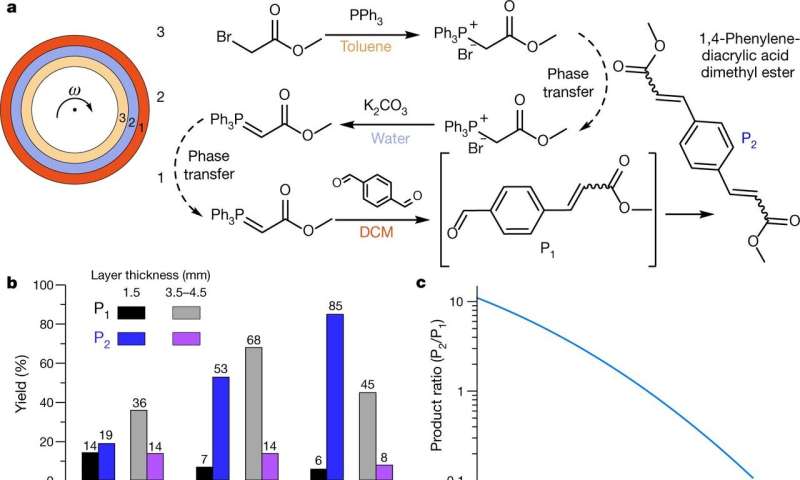Multistep organic syntheses in concentric-liquid reactors. Credit: Nature (2020). DOI: 10.1038/s41586-020-2768-9
A team of researchers from Ulsan National Institute of Science and Technology in Korea and the Polish Academy of Sciences has developed a new way to automate sequences of chemical reactions. In their paper published in the journal Nature, the group describes their new spinning device that performs multiple reactions and separations.
Historically, chemistry has been a very labor-intensive pursuit, with chemists mixing chemicals step by step to achieve certain reactions and eventually end products. Thus, scientists have been looking for ways to automate as much of the process as possible. The result has been the development of systems such as flow reactors. Unfortunately, these systems require a high degree of engineering prowess. In this new effort, the researchers have developed a new device to replace such systems, which allows for partially automating sequences of chemical reactions.
The new system looks and behaves much like a centrifuge. Chemicals are put into the device and spun. Those chemicals that are most dense wind up on the outer edges; those that are less dense wind up on the inner core. When multiple chemicals are added, the device produces gradient layers of chemicals. The device spins at 750 to 5,400 rpm, depending on the chemicals used.
Once all the chemical layers form, the chemist adds reagents, setting off a chain of events. Reactions in the innermost ring result in products that react with the next ring, and so on, until the chain reaches the outer layer. Once that reaction is complete, the desired product is left at the outer layer where it can be collected. For the device to work as desired, the speed of rotation and the order and timing of chemical and reagent additions must be calculated in advance and performed accurately.
The researchers tested their device by performing multiple reactions and separations to create several desired products, including synthesis of small molecule products. They found it could also be used to move compounds between layers. They suggest their device could be used to automate a wide range of reaction sequences.
More information: Olgierd Cybulski et al. Concentric liquid reactors for chemical synthesis and separation, Nature (2020). DOI: 10.1038/s41586-020-2768-9
Journal information: Nature
© 2020 Science X Network
























